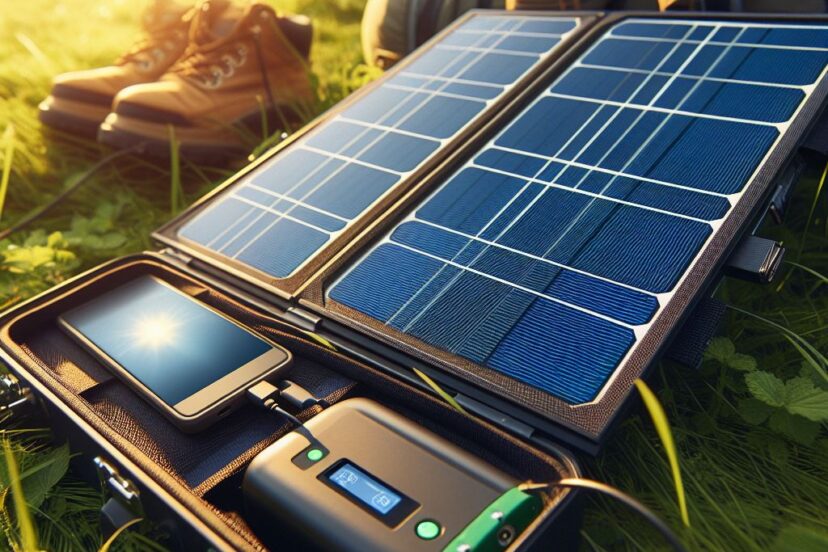Solar Panels for Camping: Harnessing Sunlight Energy
*We may earn a commission for purchases made using our links. Please see our disclosure to learn more.
Solar Panels for Camping: Essential Gear for Off-Grid Adventures
Solar energy has revolutionized the way we think about power generation and consumption, especially in remote locations. When it comes to camping, traditional electricity sources are oftentimes not available, making portable power solutions a valuable asset for outdoor enthusiasts. Solar panels for camping are specifically designed to be portable, durable, and efficient, providing a green alternative for charging electronics and lighting needs while in the great outdoors.
These solar panels come in an array of sizes and power capacities to meet different needs. They are ideal for camping because they are lightweight and foldable, which makes them easy to pack and transport. The panels can directly charge devices via USB ports or store energy in connected battery packs for later use. This technology ensures that even far from the grid, devices such as smartphones, GPS units, and cameras remain charged, enhancing both safety and convenience.
When purchasing solar panels for camping, it is critical to consider their power output, efficiency, and compatibility with your devices. The solar panel’s wattage will determine how quickly it can charge devices, while efficiency is about how well the panel converts sunlight into usable energy. Durability is also key, as outdoor conditions can be harsh, and the best solar panels for camping will be those that can withstand various weather conditions.
I’ve spent considerable time evaluating different solar panels to help campers make an informed choice. With the right solar panel, campers can maintain a sustainable energy source, even while disconnected from the traditional power grid. This not only supports a more environmentally friendly camping experience but also provides the convenience of modern technology amidst nature. The following sections will dive into the top picks for solar panels to help you keep your devices powered throughout your off-grid adventure.
Top Solar Panels for Camping
I’ve meticulously researched and compiled a list of the finest solar panels on the market ideally suited for camping enthusiasts. These products offer a blend of efficiency, durability, and portability, ensuring you have a reliable source of power while enjoying the great outdoors. Whether you’re looking to charge your devices or power your campsite, my selection caters to various needs and preferences.
ENOFLO 30W Solar Charger
I recommend this product for anyone needing reliable, portable power while exploring the outdoors.
Pros
- Impressive conversion efficiency, ideal for keeping gadgets charged
- Highly compatible with multiple devices and portable power stations
- Compact and easily transportable, perfect for any camping trip
Cons
- Limited power for high-demand devices
- Occasional charging inconsistency under variable sunlight
- The strong odor when new can be off-putting
Having just returned from a weekend camping trip, I can confidently share my experience with the ENOFLO 30W Solar Charger. Its lightweight design was barely noticeable in my backpack. Setting it up was a breeze – I simply unfolded it and hung it on a tree, thanks to the handy hiking buckle, and it immediately began fueling my small electronics.
During my trip, the charger faced rain, and its waterproofing claim held up admirably. The devices I connected via the USB and DC outputs responded well, and I was particularly grateful for the 10-in-1 connector, which allowed me to switch between charging my smartphone and tablet without fuss.
On the downside, there were moments, especially during cloudy intervals, when the power input fluctuated. However, this is a common issue with solar technology and not exclusive to this panel. In full sunlight, it performed splendidly. Moreover, when I first unpacked the panel, there was a noticeable smell, which is something to consider if you’re sensitive to odors or plan to use it in confined spaces.
All told, the ENOFLO 30W Solar Charger proved to be a robust companion for outdoor adventures, ensuring my devices stayed charged without the need for a power outlet. It’s certainly a viable option for anyone looking to harness solar energy while on the move.
BigBlue Solar Charger
I believe this solar charger strikes a great balance between functionality and portability, making it ideal for campers who want to stay connected.
Pros
- Charges multiple devices simultaneously
- High solar conversion efficiency
- Compact and lightweight for travel
Cons
- Charging speed reduced in cloudy conditions
- Can’t charge laptops or iPad Pro
- No energy storage capability
When I first unboxed the BigBlue Solar Charger, I was struck by how sleek it looked. The foldable design made it incredibly easy to slip into my backpack, and it barely added any weight, which is paramount when you’re trying to keep your luggage light for a long trek. Finding a sunny spot at the campsite, the panels soaked up the sun’s rays, providing juice for my camping group’s myriad of USB-powered devices.
Its smart charging technology was immediately noticeable. No matter what brand of phone we plugged in, the BigBlue optimized the charge accordingly. However, the absence of a battery to store energy meant that we had to time our charging sessions with the sun’s presence, a small drawback for the convenience provided.
Hiking through varied weather, the charger’s durability was put to the test. A sprinkle of rain didn’t harm the panels thanks to their protective coating. During peak daylight with the sun beaming down, I watched in amazement as my phone’s battery filled up at an impressive speed, though I noticed a significant slowdown on cloudier days.
In conclusion, the BigBlue Solar Charger is a robust companion for any outdoor venture. Efficient, user-friendly, and just as suitable for emergency situations as it is for leisure, this device won’t disappoint those looking to keep their gadgets charged and ready to go.
ALLPOWERS FlexiPanel
If you’re a camper looking for a reliable and versatile source of power, my experience tells me this solar panel might just be your go-to.
Pros
- Remarkably lightweight and portable
- Installs easily on various surfaces
- Impressive efficiency in energy conversion
Cons
- May require additional cables for third-party charge controllers
- Adequate durability in harsh weather, but handle with care
- Does not include all possible accessories for immediate full setup
Having just returned from a camping trip where I relied on the ALLPOWERS FlexiPanel, its portability left a striking impression on me. Rucksack space is precious when you’re hiking to the camping site, but this panel, weighing a mere 5.3 pounds, was easy to carry around. Its thin structure didn’t take up much space either.
Installation was a breeze. Even on my irregularly shaped RV, it conformed to curves without fuss. The six straps provided were sufficient, and within minutes the panel was securely in place. Without the need for bulky brackets, it was both discreet and aerodynamic.
Efficiency matters when you’re off-grid, and this panel delivered. it converted sunlight into usable energy with proficiency. I was pleasantly surprised by the consistent charge it provided to my gear. Sure, performance may ebb slightly in intense heat due to the lack of cooling, but this is a common trait among solar panels and not a significant detriment.
Overall, the ALLPOWERS FlexiPanel struck me as a competent companion for outdoor excursions. While certain aspects, like additional cabling for varied configurations, could enhance its versatility, it ticked most of the boxes for what I’d want in a portable energy solution.
DOKIO Solar Suitcase
I’d recommend the DOKIO Solar Suitcase for its ease of use and efficiency in keeping your camping gear powered up.
Pros
- Ready to use straight out of the box with simple setup
- Portable with a convenient handle and a long 9.8ft cable
- Adjustable bracket allows for optimal sunlight angle
Cons
- Requires careful handling to maintain connection integrity
- May need additional extension cords for certain setups
- Limited to charging 12 volts batteries, which might not suit all gear
Setting up camp, I unfolded the DOKIO Solar Suitcase effortlessly and connected the clips to my battery, making sure the polarity was correctly aligned. It started charging instantly without a hiccup, much to my relief.
Hiking out to a remote spot, the solar panel’s portability was a blessing. I appreciated the rubber handle which made carrying the lightweight unit uncomplicated. The long cable allowed me to position the panel in the perfect spot to catch the sun, even while my power station sat comfortably in the shade.
The adjustable bracket feature intrigued me; it was surprisingly robust. Tilting the solar suitcase to catch the noon sun’s rays, I noticed a significant spike in charging efficiency. It’s quite satisfying to see your gear getting charged solely by the power of the sun, especially when out in the wild.
SUNSUL Portable Solar Panel
I recommend the SUNSUL Portable Solar Panel for campers who need reliable power in remote locations.
Pros
- Impressively efficient energy conversion
- Remarkably light and foldable for easy transport
- Resilient build, suitable for harsh outdoor conditions
Cons
- Stability of kickstands could be improved
- Must have strong sunlight for optimal performance
- Connectors may require adapters for certain power stations
Having tried out the SUNSUL Portable Solar Panel on a recent camping trip, its stellar energy conversion efficiency lives up to the hype. The light streaming through the trees was harnessed effectively, proving this panel doesn’t need direct sunlight to charge my gear. Tucking it under my arm as I meandered to a sunlit clearing was a breeze thanks to its lightweight design.
Pitching the solar panel was straightforward, though I found myself wishing the kickstands were a tad more robust. While the panel handled a light breeze, a sturdier base would inspire more confidence. Nevertheless, once positioned, the device became my little power plant, keeping my camera and phone topped up throughout the day.
I appreciated the range of connectors that came with the SUNSUL. They snapped into my portable power station with ease. However, while out with friends, we noticed some power stations needed an extra adapter not included. It’s a minor gripe but something to consider if you’re thinking of investing in this versatile piece of kit. Overall, its performance was admirable, and the water-resistant design meant dew or an unexpected drizzle didn’t cause panic.
Buying Guide
Assessing Your Energy Needs
First, I determine how much energy I’ll need on my camping trip. This involves considering the devices I need to power and their consumption in watt-hours. A small, portable panel is sufficient for charging phones or GPS devices, whereas larger ones are necessary for powering coolers or laptops.
Portability and Weight
I prioritize lightweight and compact panels for ease of transport. Many panels come with foldable or rollable designs, and I check their size and weight to ensure they fit within my camping gear without adding too much bulk.
Durability
I look for panels designed to withstand outdoor conditions, including water-resistant or waterproof capabilities, and rugged exteriors to protect against drops and scratches.
Efficiency
The efficiency of a panel dictates how quickly it can charge devices. I seek out high-efficiency panels to ensure I get the most energy out of the available sunlight.
Additional Features
I consider panels with built-in stands, multiple USB ports, and integrated battery packs for convenience. Having these features can enhance the overall usability of the solar panel in various camping situations.
Here is a simple table summarizing the key features to consider:
| Feature | Why It’s Important | What to Look For |
| Efficiency | Determines charging speed | High conversion rates |
| Durability | Ensures long-term usability | Water-resistant, rugged materials |
| Portability | Affects ease of transportation | Lightweight, foldable/rollable |
| Power Needs | Matches panel to energy demands | Sufficient wattage for devices |
| Extra Features | Adds to convenience | Built-in stands, multiple ports |
Please note, thorough research and careful consideration of these aspects are crucial in selecting the best solar panel for camping needs.
Frequently Asked Questions
In this section, I cover the essentials for anyone interested in leveraging solar power while camping. I’ve zeroed in on popular queries and provided clear answers for outdoor enthusiasts.
1. What are the best solar panel kits for camping?
The best solar panel kits for camping typically offer durability, portability, and a high power output. I recommend brands like Goal Zero, Renogy, and Jackery, as they provide balanced solutions for various camping scenarios.
2. How do I determine the amount of solar power needed for my camping trip?
To calculate solar power needs, first, total the wattage of all the devices you plan to use. Then, estimate the number of hours each device will operate daily. Multiplying the total wattage by the hours will give you the watt-hours required per day, guiding your solar panel choice.
3. Can a 200 watt solar panel be sufficient for camping needs?
A 200 watt solar panel is usually sufficient for basic camping needs such as charging small electronics and some light appliances. If your energy consumption is moderate or you’re camping for a short period, this should suffice.
4. What are the top-rated portable solar panels for camping purposes?
Top-rated portable solar panels for camping are known for their efficiency and ruggedness. Brands like Anker, Rockpals, and Bluetti often come up as leaders in the space, offering panels that efficiently convert sunlight to electricity and withstand the rigors of outdoor use.
5. How effective are solar panels for running camping fridges?
Solar panels can be effective for running camping fridges, but the efficiency hinges on several factors like the fridge wattage, insulation quality, and average sunlight exposure. For optimal effectiveness, pair solar panels with a suitable battery bank to ensure uninterrupted power.









